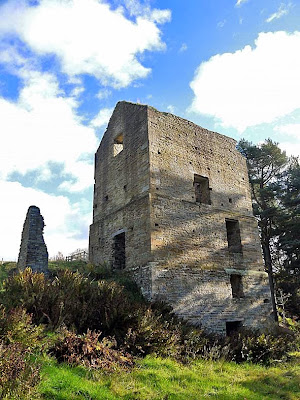Wednesday, November 20, 2013
The Industrial Revolution in Reverse - Steam gives way to Water Power
Thursday's Guardian Country Diary describes an unusual piece of industrial archaeology in a remote Northumbrian valley.
This is the sight that greets you when you follow the track down from the delightfully-named Pennypie cottage towards Blanchland, at the mining hamlet of Shildon (not to be confused with the town of Shildon in County Durham) which is a mile north of Blanchland. All that's left of this community, that in its heyday numbered over 150 people, is a couple of cottages and this old engine house, together with some mine shafts in the hillside.
The engine house was built in 1806 by mine owner John Skottowe, to house a Boulton and Watt steam engine that was built to pump water from the underground lead mine shafts and tunnels. Waterwheel-driven pumps were no longer up to the job so he imported the latest technology from the tin mines of Cornwall. A contemporary account describes how 'a steam-engine of great power was erected, the cyclinedr being of 64 inches in diameter, and the main beam weighing upwards of nine tons'.
It should have solved Skottows' problems especially as he owned coal mines across the border in County Durham, but the steam engine turned out to be uneconomic and he reverted to waterwheel driven pumps, dismantling the steam engine and transporting it to Backworth colliery. There was no rail access to Blanchland when the mine engine was installed and even when a rail link did arrived (in 1834) the line ended at Parkhead, five miles away.
The likely reason why steam-driven pumping was abandoned is that this little valley is so remote Even today the roads quickly become treacherous after a snow fall and two centuries ago, when they were less well maintained and horses and carts were used, they must often have been impassible in winter.
After the steam engine was removed the building was converted to miners' accommodation, with the addition of three floors inside, and it became known locally as 'Shildon Castle'. The mine went into decline, unable to compete with imported lead, and many of the miners emigrated - you can read fascinating accounts of some of them by clicking here
This is the slit in the wall where the beam of the steam engine would have rocked up and down. At the top of the slit you can see the fireplaces that were installed when the building was converted to workers' flats.
You can see more photographs of the site, before its recent restoration, by clicking here
There was a vigorous exchange of mine workers and mining technologies between Cornwall and Northumberland in the early 19th. century, which you can read about by clicking here
You can download a useful pdf guide to the geology and landscape around Blanchland by clicking here
You can download a detailed report on Blanchland and its surround area by clicking here
Labels:
Blanchland,
geology,
Guardian Country Diary,
lead mining,
Shildon
Subscribe to:
Post Comments (Atom)
































An excellent post. This is another place to add to my list.
ReplyDeleteIt's well worth a visit, Adrian - and Blanchland is a very attractive village, even though the pub shut down last year.....
Delete